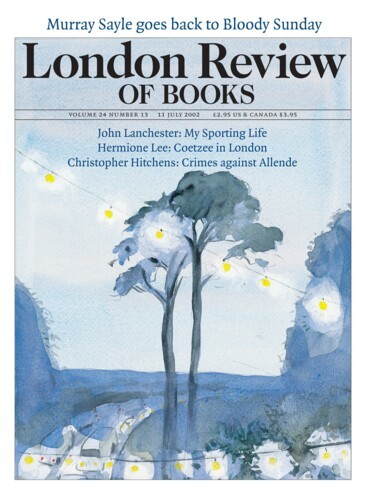Tom Clancy, as his fans already know, has a new novel coming out in August. When he first revealed its gestation, at the beginning of 2001, he said its working title (or ‘codename’, as www.clancyfaq.com prefers) was ‘The Red Rabbit’, but this was likely to change as it was ‘too stylised’ – and perhaps too Updiked, though Clancy didn’t mention that. So the stylised definite article has been dropped, and Red Rabbit will be hopping its way up the bestseller lists in a matter of weeks (Michael Joseph, £18.99).
Clancy rocketed to fame – the cliché isn’t inapt for such a notorious gizmologist, though he’d no doubt give you the make and serial number of the rocket in question – in the mid-1980s with his first novel, The Hunt for Red October. The story of the Lithuanian captain of a Soviet submarine defecting to the West, taking his brand-new ship with him, was first published by the Naval Institute Press – ‘the semi-official mouthpiece’, in Clancy’s words, ‘of the US Navy’. Nobody, least of all Clancy, at the time an insurance broker with an enthusiasm for naval history, expected it to be quite the success it was. Forgetting for the moment the submarine captain, Marko Ramius (Sean Connery, for those who’ve seen the movie), the book’s hero is Jack Ryan, a young CIA analyst who has featured in most and starred in many of Clancy’s subsequent novels. His second, Red Storm Rising, about a conventional Third World War that turns out not to be all that disastrous unless you’re German, is rare in being set outside the ‘Ryanverse’, as it’s known to devotees. It’s also the only one of Clancy’s books to have been graced with a review in the LRB. David Rieff concluded: ‘America loves Colonel North and Colonel North must love Red Storm Rising. I would ban it if I could’ (LRB, 3 September 1987). I don’t suppose the presence of Jack Ryan would have eased his mind much.
Ryan’s career has been filled in over the years: you can find out how he was recruited to the CIA in 1981 after foiling an IRA attempt on the lives of the Prince and Princess of Wales (Patriot Games); how he became acting deputy director of Intelligence (Clear and Present Danger); how he was appointed National Security Adviser and then Vice-President when the incumbent had to resign because of a sex scandal, and then became President after a terrorist attack on Washington killed just about every other politician in the US (Debt of Honor and Executive Orders). The mastermind behind the attack is a Japanese businessman who hates America because his father committed suicide rather than surrender to US Marines in WWII. Clancy’s most recent novel, The Bear and the Dragon, is set during Ryan’s Presidency and revolves around skulduggery in Russia and China (hence the title).
Red Rabbit, however, is a nostalgic look back to Ryan’s apprenticeship in the CIA, before the Red October set sail. Debriefing a defector from the USSR during the last days of Brezhnev, Ryan learns that a cabal of top-ranking Soviet officials, Andropov among them, is planning to assassinate the Pope. Christ knows why they would want to do something like that – maybe it’s because they’re really evil – but anyway, that’s the plan. Clancy’s apparent clairvoyance has been remarked on: ‘Want to read Clancy’s book that had an airplane crashing into the Capitol?’ clancyfaq.com asks. ‘See Debt of Honor for the crash (and why it happened) and Executive Orders for the aftermath (in which JPR responds in much the same way that our President is now responding).’ Red Rabbit was in the making long before the attacks on the World Trade Center, evidence perhaps that Clancy had a premonition of a market for a novel that returned to the cosy certainties of the Cold War, a time when we could be sure of our enemy and where his castle was, a time when the Pope was young.
Clancy might like Alfred Crosby’s Throwing Fire: Projectile Technology through History (Cambridge, £20), which follows the fascinating trajectory from the first rock chucked at a squirrel by a hominid during the Pliocene epoch (five to two million years ago) to space travel. Think opening sequence of 2001: A Space Odyssey with the missing years filled in (and without those black monoliths): spears, darts, bows and arrows, gunpowder, V-2s (the V is for Vergeltungswaffe, or ‘Vengeance Weapon’), atom bombs – and peaceful things, too, like cricket balls and space probes, though rather fewer of them.
Send Letters To:
The Editor
London Review of Books,
28 Little Russell Street
London, WC1A 2HN
letters@lrb.co.uk
Please include name, address, and a telephone number.

